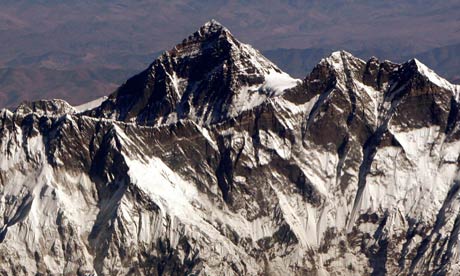Picking Up The Trash
We humans do have an irresolvable problem of junking up our atmosphere. As well as our geography. We produce junk and then discard it. With amazing regularity. Whether we leave all that junk, including human feces, in the Himalaya, covering the slopes of the mountains, littering the majestic Mount Everest with discarded oxygen tanks, food wrappings, plastic bottles and containers, tents or anything else fatigued adventurers cannot manage to haul back with them, we degrade our environment.

Mount Everest – more than 2,500 people have reached the summit since Edmund Hillary in 1953. Photograph: Desmond Boylan/REUTERS
Expeditions have been mounted with all their climbing gear intact, the participants determined to clear out as much detritus off the mountainsides as possible. A Nepali environmental group has petitioned the government in Kathmandu to enact new legislation to make it mandatory to have portable toilets at camp sites.
Clean-up crews have done a credible job of cleaning up messes left behind by doughty expeditioneers unconcerned by what they leave behind. But the solution, they claim, is not clean-up after the fact, but insisting that litter not be tolerated to begin with. Standards should be well understood to begin with.

European Space Agency Since the Sputnik soared into orbit 1957, there have been thousands of launches into space. But close to 95% of the man-made objects now in orbit are debris, which includes a growing collection of defunct satellites rocket boosters and chunks of metal. Debris from in-orbit explosions and collisions account for more than half the catalogued man-made objects in orbit. This artists’ image is based on actual data. However, the objects are shown at an exaggerated size
The Canadian Space Agency has been forced to take precautionary measures on a number of occasions to protect Canada's $500-million Radarsat satellites, thrusting them out of the way of potential collisions. Some of the debris results from missile tests, rocket launches and mid-orbit collisions, and the prevalence of near-misses is increasing. A problem on the increase, and one that must be dealt with.
It is estimated that over 16,000 chunks of debris, from the size of baseballs to refrigerator-size are whipping about our planet. That includes everything from dead satellites to rocket boosters, to tools accidentally dropped into space by astronauts. The sheer numbers of junk circulating in space lead to what scientists term a "cascade effect", with one collision causing bits to break off larger pieces of junk, creating even more in circulation and increasing the numbers of collisions.
With each collision the fragments become smaller, but even the very small ones can be the cause of catastrophic collisions. That area of space roughly 800 to 1,000 kilometres above Earth is considered one of the most vulnerable, since it is where satellites monitor the environment and military operations. It is full of satellite traffic, and with a great concentration of space junk.
An estimated 16,000 pieces of junk are now circulating in space, according to data from the European Space Agency. That's large pieces; that number does not include hundreds of thousands of smaller pieces of debris which travel at inconceivable speeds of thousands of kilometres an hour. The U.S. Strategic command now regularly issues alerts warning of objects on track for collision.
There are alerts going out almost every other week warning of space trash heading for a Canadian satellite. Rocket stages remaining in the space as a result of space launches, looking like "giant gas cans" have the reputation of being especially troublesome, since they are capable of retaining enough fuel to explode on contact with an obstacle.
The world's telecommunication satellites responsible for maintaining the world's cellphones and televisions in operational mode are located 36,000 kilometres above Earth in what is considered to be geostationary orbits, "parked" in orbit, appearing to be stationary. When they've outlived their usefulness they are boosted several hundreds of kilometres into further space, into "graveyard" orbits.
Some satellites plunge back to Earth, and mostly they land in the Pacific Ocean, if we're lucky enough. Some make their fiery re-entries far from human habitation. The bus-sized European earth observation satellite Envisat, due to retire in 2013 hasn't enough fuel to be boosted into graveyard orbit, and if it is hit by space junk it could shatter into a waterfall of space junk.
Leading the scientists who worry about all these scenarios to consider the practicality and feasibility of launching robotic service vehicles into space whose purpose it would be to mechanically collect and sweep up the circulating space trash that poses such grave hazards.
Labels: Canada, Environment, European Union, Space, United States
posted by Pieface @ Sunday, January 22, 2012
![]()
![]()

<< Home